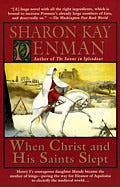"And they said openly that Christ and his saints slept," says the twelfth century Peterborough Chronicle about the eighteen years of warfare between Stephen and Maude, known as "the Anarchy."
William the Conqueror's son Henry I named his daughter Maude as his heir. When he died in 1135, Maude's cousin Stephen reached London at white-hot speed before she could arrive from the Continent. Stephen broke his oath to defend her, claiming the crown for himself. Many of the barons were reluctant to accept Maude not only because of her gender, but also because of her husband, the hot-tempered Geoffrey of Anjou. Instead, they supported Stephen. Thus began a long and bitter war that devastated England, most of whose people did not care which claimant sat on the throne, if only they could have peace.
Penman portrays Stephen as an essentially kind man whose eagerness to please makes him a weak king, hesitant and vacillating, unable to make the difficult choices necessary to maintain his rule and establish peace. By contrast, Maude is so intent on establishing control after seven years of subjugation to a quarrelsome, philandering husband eleven years her junior, that she is overly rigid and punitive, making enemies of people whose support she desperately needs. Some readers may find it difficult to fully sympathize with either of these characters, whose flaws reflect a historical record of appallingly misguided decisions. The story is brightened, though, by a fictional, illegitimate half-brother of Maude's, the exuberant young Ranulf. About halfway through, Maude's remarkable eldest son, the future King Henry II, emerges as a driving force in the plot and is portrayed in a series of vivid, compelling scenes.
Penman's faithfulness to history makes When Christ and His Saints Slept slow reading at times, given the multiplicity of characters, battles and political betrayals, but readers who prefer novels that stick closely to the historical record over those which adopt composite characters and simplified chronologies will appreciate its level of detail. (1995, 746 pages including an Author's Note separating history from fiction)




